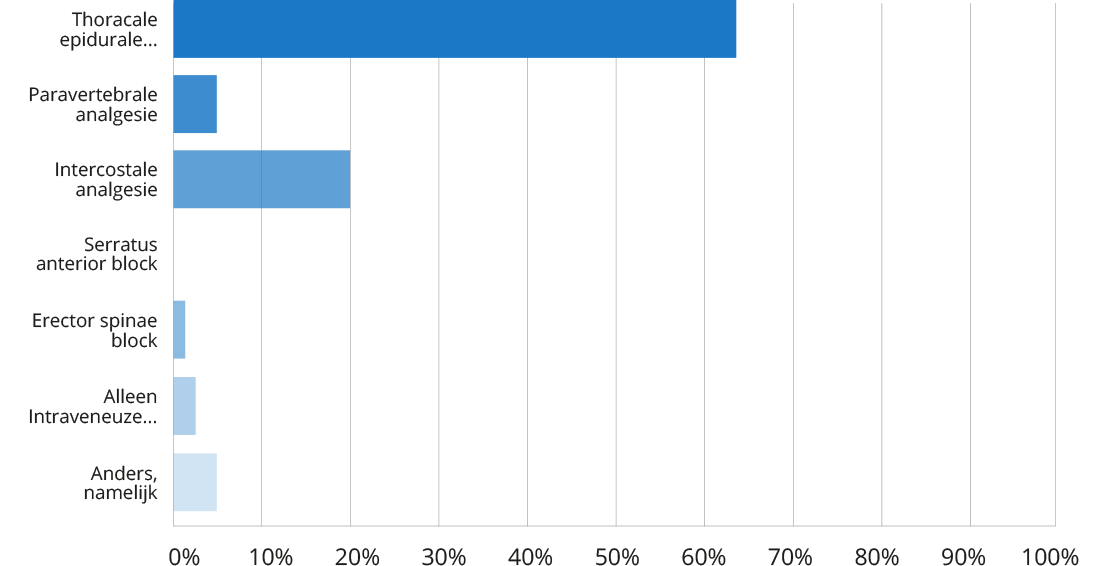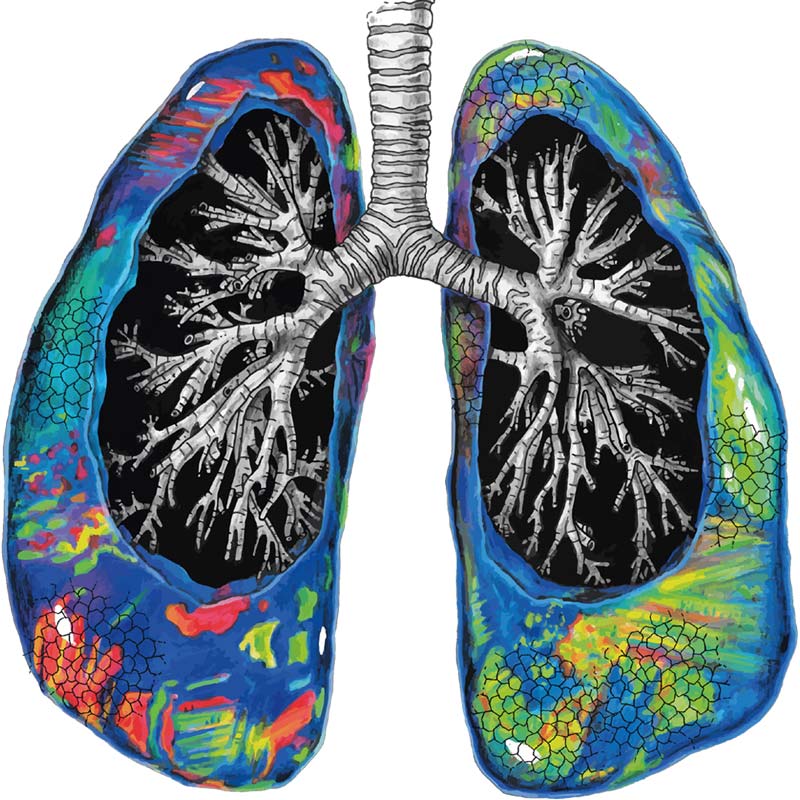Informatie voor artsen
Uit een onderzoek onder Nederlandse long- en thoraxchirurgen zijn dit de meest gebruikte analgesie technieken bij VATS in Nederland:
Thoracale epidurale analgesie: 64.41% (38 respondents)
Paravertebrale analgesie: 5.08% (3 respondents)
Intercostale analgesie: 20.34% (12 respondents)
Serratus anterior block: 0% (0 respondents)
Erector spinae block: 1.69% (1 respondent)
Alleen intraveneuze en/of orale analgesie: 3.39% (2 respondents)
Anders, namelijk: 5.08% (3 respondents)
Adequate pijnbestrijding na video-assisted thoracale chirurgie (VATS) voor longresectie is belangrijk om postoperatieve mobilisatie en herstel te verbeteren en om postoperatieve pulmonale complicaties te voorkomen.
Thoracale epidurale analgesie (TEA) is de “usual care” voor postoperatieve pijnbehandeling na thoracale chirurgie. Hoewel het pijnstillende effect van TEA duidelijk is, is het percentage mislukkingen 9-30% [1, 2, 3] en is een wakkere plaatsing stressvol voor patiënten. Bovendien wordt TEA geassocieerd met immobilisatie van de patiënt, disfunctie van de blaas en hypotensie [4]. Op basis van het beste beschikbare bewijs en de recente richtlijnen van de Enhanced Recovery After Surgery (ERAS) vereniging, neemt de European Society of Thoracic Surgeons (ESTS) vroege mobilisatie na een operatie op als een van hun belangrijkste aanbevelingen [5].
De nadelen van de TEA waren de inleiding voor de ontwikkeling van unilaterale locoregionale technieken voor pijnbestrijding. Single-shot en continue paravertebrale, intercostale, serratus anterior en erector spinae blokken zijn veilig en effectief gebleken [6].
De Nederlandse Vereniging voor Longchirurgie (NVvL) en Thoraxchirurgie (NVT) geven geen richtlijnen voor postoperatieve pijnbehandeling. De Nederlandse richtlijndatabase en de ESTS-richtlijn rondom ERATS implementeren alle TEA en andere regionale technieken als geldige opties voor pijnbestrijding na VATS.
Referenties
- J. Hermanides, M.W. Hollmann, M.F. Stevens, P. Lirk. Failed epidural: causes and management. British Journal of Anaesthesia 109 (2): 144–54 (2012)
- N. T. Ventham, M. Hughes, S. O’Neill, N. Johns, R. R. Brady and S. J. Wigmore. Systematic review and meta-analysis of continuous local anaesthetic wound infiltration versus epidural analgesia for postoperative pain following abdominal surgery. British Journal of Surgery 2013; 100: 1280–1289
- Sugantha Ganapathy, Rakesh V. Sondekoppam, Magdalena Terlecki, Jonathan Brookes, Sanjib Das Adhikary, Lakshmimathy Subramanian. Comparison of efficacy and safety of lateral-to-medial continuous transversus abdominis plane block with thoracic epidural analgesia in patients undergoing abdominal surgery: A randomised, open-label feasibility study. Eur J Anaesthesiol 2015; 32:797–804
- A. Clemente, F. Carli. The physiological effects of thoracic epidural anesthesia and analgesia on the cardiovascular, respiratory and gastrointestinal systems. Minerva Anestesiologica 2008; 74: 549-63.
- Timothy J.P. Batchelor, Neil J. Rasburn, Etienne Abdelnour-Berchtold, Alessandro Brunelli, Robert J. Cerfolio, et al. Guidelines for enhanced recovery after lung surgery: recommendations of the Enhanced Recovery After Surgery (ERASVR) Society and the European Society of Thoracic Surgeons (ESTS). European Journal of Cardio-Thoracic Surgery 55 (2019) 91–115.
- Marzia Umari, Valentina Carpanese, ValeriaMoro, Gaia Baldo, Stefano Addesa, et al. Postoperative analgesia after pulmonary resection with a focus on video-assisted thoracoscopic surgery. European Journal of Cardio-Thoracic Surgery 00 (2017) 1–7.
- Marzia Umari, Stefano Falini, Matteo Segat, Michele Zuliani, Marco Crisman. Anesthesia and fast-track in video-assisted thoracic surgery (VATS): from evidence to practice. J Thorac Dis 2018;10(Suppl 4):S542-S554.



